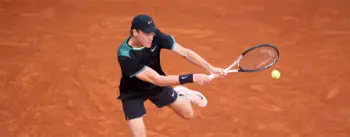Best Latest Tennis Odds – How Do Tennis Betting Odds Work – Odds Explained
The concept of odds can be confusing if you are new to online tennis betting. What do they represent, how to calculate them and most important, how to find value betting opportunities. For that reason, we’ve created a dedicated article on how tennis betting odds work, as well as the current latest tennis odds from our recommended bookmakers.
Latest Tennis Odds
For betting, we refer to these sportsbooks as of 2025:
What is the best betting site for tennis?

Popular betting site in Canada with a huge tennis odds selection! Use promo code TENNISNERD for a good welcome match bonus of up to C$180!


A new, big betting site with tons of odds, fun games and promotions. Available in most countries worldwide.


The online sportsbook for the serious bettor, with very high limits and a always fair odds! No bonuses available.


Big sportsbook with great odds! Accepts US and Canada players, and takes both crypto and dollars.



US gaming site with a huge sportsbook and great odds! Also accepts crypto deposits.



A popular betting site for US bettors, with high limits, fast withdrawals, a lot of promos and an overall great sportsbook!


Accepting US bettors, claim some big welcome bonuses and get good tennis odds! Use code TENNISNERD for a great bonus.



Get a 100% match deposit bonus in the sportsbook! Good tennis odds and live betting.


Big and popular betting site with a huge tennis odds selection! Use promo code TENNISNERD for a good welcome match bonus (amount depends on your country). Available in many languages.











A new, big betting site with tons of odds, fun games and promotions. Available in most countries worldwide.










The online sportsbook for the serious bettor, with very high limits and a very good odds! No bonuses available.





One of the top rated sportsbooks, very user friendly and great rewards. Only accepts crypto payments.







Learn More About Odds in Tennis
Understanding this concept is crucial to start betting on tennis, as a lack of comprehension can result in significant losses. Winning money in betting is not easy, so you must make sure you know all the different aspects to increase your chances of winning.
We will not only explain how tennis betting odds work, but also the different format of odds. As you will see, there are different formats that can be used, depending on your preference and also your country.
So what can you find on this page?
- What are Tennis Betting Odds?
- Why do Tennis Betting Odds Change?
- How to Find Value Tennis Betting Odds
- FAQ – Frequently Asked Questions
What are Tennis Betting Odds?
Betting odds represent the probability of a certain event and indicate how much you can win by placing a bet. These are not random numbers; they all have a mathematical explanation and translate the percentage of some result to occur.
The logic is quite simple, the higher the odds for a tennis match, the bigger the payout you can get from your bets. However, the likelihood of winning a bet decrease as odds increases, since the percentage of that event to occur is lower.
On the other hand, more likely results will have lower odds, which mean smaller potential winnings. If something is more likely to happen the sportsbooks won’t give you such a good return if that happens.

But how can you win money in tennis with the different betting odds? The answer is simpler than it looks. All you must do is to find tennis matches where the betting sites are giving odds that are not a reflection of the true probability. It might sound confusing, but we will get back to that in a minute.
Going back to betting odds, there are different formats and the way you calculate the percentage and potential winnings is different. For that reason, the first step to understand how tennis betting odds work is to get familiar with the different formats.
There are three different odds formats that sportsbooks use for tennis betting and other sports:
We will see in more detail how each of them works, so you can decide which is the ones that suits you best as a bettor.
American Odds
As the name suggests, American odds are very popular in the United States and can be found at any of the best sportsbooks in the US for tennis betting. This odds format is represented by a plus or a minus sign in front of the number, depending on the probability of happening.
Favorites have a minus (-) sign and represent how much you will need to bet to win $100. The higher the number on the odds, more likely is that event to occur. For example, a -300 favorite is more likely to win than a -150 favorite, as you will need to bet $300 on the first to win $100 while on the second you just need to bet $150 to get the $100 of profit.
On the opposite side are the underdogs, which have a plus (+) sign and show you how much you can profit with a $100 bet. The higher the number, the better the payout, but also less chances of happening. That said, an underdog of +150 has more chances of winning than another with American odds of +400.
Example of How American Odds Work in Tennis
Below you have an example of how sportsbooks usually display information for tennis betting in American odds:

As mentioned before, negative numbers indicate favorites while positive numbers indicate underdogs.
For this example, Alison Van Uytvanck is the favorite to win the match and five-games favorite on the spread.
One thing to notice is that the game handicap, or spread, line has very similar odds. This is the way sportsbooks offer similar odds for both players, not on who will win the match, but on the difference of games between them.
Understanding Payouts in American Odds
The payouts for your bets consider how much you have wagered and the odds from when you placed your bet. Even though the odds are always adjusting according to different factors that we will talk later, when you place a bet, those are the odds that you got.
When you are placing your tennis bets with American odds, the betting slip on the sportsbook page will show you your potential winnings, which are not including your stake.
Negative Odds – Favorite
- Odds of -120: Bet $120 to win $100
Positive Odds – Underdog
- Odds of +120: Bet $100 to win $120
In case you want to bet other amounts, then you will need to calculate using the same ratio. For example, if you want to win $10 on the favorite above, then you will need to bet $12.
Calculate Probability from American Odds
As mentioned before, the betting odds in tennis or any other sport reflect the probability of a certain event to happen. But how exactly do you calculate the probability with American odds?
There are plenty of sites that will help you calculate the probability from American odds, but we recommend that you also know how to do it. The best bettors are those who understand every single detail and the logic behind every calculation. Below you can find the implied probability calculation for both negative and positive American odds.
Negative Odds
Probability = Odds / (Odds + 100) x 100
- Odds of -120 (use positive numbers for calculation)
- 120 / (120 + 100) x 100 = 54.55%
Positive Odds
Probability = 100 / (Odds + 100) x 100
- Odds of +140
- 100 / (140 + 100) x 100 = 41.67%
Calculating the implied probability for the odds is crucial to be successful in tennis betting on the long run. Only after doing this, you’ll be able to determine if there is any valuable opportunity to invest your money.
Later in this article we’ll look at some examples of how you can find value tennis bets with American odds or any other odds format.
Decimal Odds
Decimal odds are the most popular all over the world, expect in the United States and United Kingdom. The reason for their popularity is because they are incredibly easy to understand than other formats.
All betting sites in EU and Canada for example, have these as their default odds. The odds are represented by a decimal number, starting from 1.01 and increasing as the event gets less likely to happen.
Looking at the difference between favorites and underdogs, the turning point in decimal odds is 2.00. These odds are also known as evens and separate favorites from underdogs. That said, all tennis bets in decimal odds above 2.00 will be considered underdogs and will offer a higher payout if successful.
Example of How Decimal Odds Work in Tennis
To help you better understand how decimal odds work, we will take a look at how sportsbook usually display the information on this odds format.

As you can see, Anna Kalinskaya is the favorite to win the match as her odds are below 2.00 and she has a -3.5 spread on the game handicap (learn more about hcp betting in tennis). On the other hand, Lesia Tsurenko has much higher odds as she is the underdog and less likely to win this match.
If you look at the image you can also see that both the game handicap and the total of games have very similar odds. This has the same reason, as the sportsbooks want to make it as even as possible for players to bet on these tennis markets.
Understanding Payouts in Decimal Odds
One of the things that makes decimal odds so popular is how easy it is to calculate your potential payouts. The math behind it is very simple and you just need a few seconds to know how much you can win with a certain bet.
When you are placing your bet on a tennis match with decimal odds, the sportsbook will show you the information of your winnings. This means that your stake is not included on the amount displayed on the betting slip.
An Example of Potential Payouts
You bet on Alexander Zverev to beat Dominic Thiem for $100 at decimal odds of 1.85, which means he will be the favorite to win the match.
To calculate your potential payouts you need to do the following:
- Stake ($100) x Decimal Odds (1.85) = $185
You will risk $100 to get a payout of $185, leaving you with a profit of $85 with this bet
Let’s look at another example, this time of an underdog.
You back Frances Tiafoe, an underdog against Stefanos Tsitsipas, for $100 at decimal odds of 2.85 to win the match.
The math to calculate your potential payout is the following:
- Stake ($100) x Decimal Odds (2.85) = $285
You will risk $100 to get a total payout of $285, meaning that you get a profit of $185 if Tiafoe wins the match.
Don’t forget that when you are placing your bets with decimal odds, your stake is also calculated into your potential winnings. For that reason, you always need to remove the stake in order to determine the potential net profit from your tennis bets.
Remember also that the breakeven point for decimal odds is 2.00, as these odds will double your money if successful. Decimal odds in tennis betting below 2.00 will pay less than the stake while odds above 2.00 have a potential return higher than your initial stake.
Calculate Probability from Decimal Odds
We saw before how to calculate the implied probability with American odds, but how can you do it with decimal odds? The process is even simpler than we saw before, making this odds format so popular for those interested in tennis betting.
Unlike what happens in American odds, where you have one calculation for negative odds and another for positive odds, om decimal odds you just need one calculation. The process is incredibly simple, and we’ll show below how you can do it yourself.
Probability = 1 / Decimal Odds x 100
- Odds of 1.80
- 1 / 1.80 x 100 = 55.56%
Let’s see another example, this time with an underdog
- Odds of 2.30
- 1 / 2.30 x 100 = 43.48%
Every successful person in tennis betting knows how important it is to calculate the implied probability from decimal odds or any other format. This will help you understand if there is any good opportunity to get an edge over the sportsbooks.
Understanding the different betting markets is also very important for those who want to know how to bet on tennis, in order to make the best decisions when placing their bets.
Fractional Odds
The last odds format sportsbooks use is fractional odds, and these are very popular among British bettors. As the name suggests, the odds are presented as a fraction and give you information of how much you can profit from your bet.
All the best bookmakers in the UK for tennis betting will have these as their default odds as soon as you enter the site. The odds can go from as low as 1/100 and will increase as the outcome gets less likely to occur.
The different between favorites and underdogs in fractional odds is when the numerator surpasses the denominator. This means that, every fraction where the numerator is lower than the denominator, such as 2/5, is a favorite. On the other hand, fractional odds of 3/2 are referring to an underdog and will give you a higher payout.
Example of How Fractional Odds Work in Tennis
Below you have an example of a tennis match to understand how fractional odds work. For this situation we used the match between Danka Kovinic and Anna Bondar for the WTA Lyon, a tournament where you can bet on hard court that takes place every year in February.

As you can see in the image above, Kovinic is the favorite at 11/16 as the numerator is smaller than the denominator. She’s also a two-point favorite in the spread against Bondar, who has odds of 5/4 to get the win.
Both the fractional odds for the game handicap and total number of games are quite close on this tennis match, as the bookmakers are trying to make it close to evens on both lines.
Understanding Payouts in Fractional Odds
Fractional odds are very popular in the UK as they are advertised everywhere. If you’ve been to London, for example, it’s almost impossible not to pass by a betting shop where you can see these odds being advertised.
However, understanding the potential payouts might not be as simple as it is for decimal odds, and that’s one of the reasons why they are not so common in other parts of the globe.
When looking at the fractional odds, they will show you how much will be your winnings, not your returns. Remember that return is what you will get if you win the bet, including your stake. If you’re betting on tennis with fractional odds, you will just see the information of your potential profits.
Example of Payout of Fractional Odds Bet
Let’s see an example where you bet $50 on Andrey Rublev to beat Grigor Dimitrov at fractional odds of 3/5, meaning that he is the favorite to get the win on this tennis match.
To calculate your potential winnings, you need to use the following formula:
- Stake ($50) x Fractional Odds (3/5) = $30
You will risk $50 to get winnings of $30, meaning that the total return will be $80 if you win this bet.
Let’s see another example of payout work in fractional odds for tennis betting, this time with an underdog.
This time you bet on Tommy Paul against Casper Ruud for $50 at fractional odds of 5/2 on the moneyline.
The calculation needed to know your potential winnings is:
- Stake ($50) x Fractional Odds (5/2) = $125
On this case you will risk $50 to get winnings of $125, which means that your total return for this bet is $175 if Paul gets the win over Ruud.
Once again, don’t forget that fractional odds reflect your potential winnings, and not return. This is very important as it differs from decimal odds, for example, where the odds show your potential returns and not winnings.
Remember also that the turning point from favorite to underdog in fractional odds is 1/1, which is the point where the numerator will overtake the denominator. Fractional odds in tennis betting where the numerator is smaller than the denominator is on favorites, while underdogs have bigger numerator than denominator.
Calculate Probability from Fractional Odds
The last thing we’ll see about fractional odds is how you can calculate the implied probability of those. Even though the process is not as simple as in decimal odds, it’s still a basic calculation and you will get the information quite easily.
As it happens on decimal odds, you can use the same calculation for both favorite and underdogs. Below we will see the formula and a few examples to help you understand how you calculate probability from fractional odds for your tennis bets.
Probability = Denominator / (Denominator + Numerator) x 100
- Odds of 2/5
- 5 / (5 + 2) x 100 = 71.43%
Let’s look at another example, this time of an underdog:
- Odds of 7/2
- 2 / (2 + 7) x 100 =22.22%
We can’t stress enough how important it is to know how to calculate the implied probability from fractional odds, or any other format, when placing your tennis bets. This will be crucial to find good value opportunities to get some advantage over the sportsbooks.

Why do Tennis Betting Odds Change?
Before we get into more details of explaining why odds change, it’s important to understand some basic concepts. Sportsbooks are companies as any other, therefore, their goal is to make money. They don’t take bets just for the sake of it, they know what they are doing and look to maximize their returns.
When taking bets in a tennis match, for example, the sportsbooks are looking to guarantee profit regardless of the outcome. This might sound strange, but that’s exactly what they do. You might not now, but every time you place a bet you are paying a “hidden fee” to the sportsbook, known as vig or overround.
If you have some experience with tennis betting, you might have noticed that the odds always have a certain margin on them. For example, the spread has odds close to evens, but both sides have a slightly below price. That difference is the margin of the sportsbook and how they will make money with tennis betting, or any other sport, in the long run.
Let’s look at a quick example to help you understand this concept:
For this example, image you’re betting on clay in a match between Alexander Zverev and Daniil Medvedev. Below are the tennis betting odds for both players, in decimal and American format.
- Zverev: 1.90 (-111)
- Medvedev: 1.90 (-111)
If you bet $10 on Zverev and win your bet, you’ll get a profit of $9. On the other side, a bet of $10 on Medvedev will also result in a $9 profit. That said, the sportsbook will always profit if they get the same amount of bets on both sides.
Let’s see how much the sportsbook will profit if they get $10 of bets in both sides.
- Total Bets: $20
- Total Payouts: $19
- Sportsbook Profit: $1
Regardless of the outcome, the sportsbook will also make money as they got $20 in bets but just need to pay $19 to the players. This $1 difference is their vig, also known as overround or margin.
However, it’s important to clarify that it’s extremely rare that the sportsbook can get the same amount of risk on all the different outcomes in a tennis match. That’s why sportsbooks need a good risk management, to make sure they balance their liabilities and reduce their risk. For that, they have some techniques and strategies to adjust the tennis betting odds and balance their risk.
Set the Opening Odds
The first thing sportsbooks need to do is set the opening odds for a tennis match. This process is usually done by very sophisticated algorithms, but they are not always 100% corrects. There are always external and human factors that need to be considered and that’s very hard for a mathematical model to predict.
Sports are played by humans and there are a lot of things that can have an impact on a match performance. If you are betting on a tennis match, for example, it’s unlikely that the opening odds are taking considering off-court factors, such as personal problems, for example.
This means that sportsbooks will usually receive a significant amount of bets, in tennis or any other sport, after releasing the opening odds. These are made by very smart bettors, also known as sharp, who know exactly how to take advantage of these inefficiencies in the opening odds.
Because of this, the sportsbooks need to have certain procedures and strategies to reduce risk and exposure. When they are receiving a large number of bets on a certain tennis match outcome, they need to adjust their odds accordingly.
Adjusting Tennis Betting Odds
In a perfect scenario, for the sportsbooks, they would be 100% accurate when setting their opening odds and there wouldn’t be the need of adjusting them. Bettors would place their bets and the bookies would have the same amount of exposure on both sides, meaning that they would always profit their vig.
Nevertheless, we already saw that this is not possible. They often make mistakes on their opening odds and offer valuable tennis betting opportunities, which means that they need to adjust their odds.
Going back to the previous example of the match between Zverev and Medvedev, the opening odds for both tennis players were 1.90, or -111 in American odds. Let’s assume that most of the bettors believe Zverev’s odds have value and start betting on the German. On the other hand, very few bets are placed in Medvedev, leaving the sportsbook with the following after 100 bets.
- Zverev: $8,500 wagered at 1.90 (-111)
- Medvedev: $1,500 wagered at 1.90 (-111)
The sportsbooks received a total of $10,000 in tennis bets, but their risk is not the same in both outcomes. In the current scenario they have the following liability on both players:
- Zverev: $16,150 (-$6,150)
- Medvedev: $2,850 (+$7,150)
As you can see, the sportsbook has a very significant risk on Zverev’s side, as they will lose $6,150 if he wins the match. On the other hand, they will profit a total of $7,150 if Medvedev is the winner.
This leaves them in an unpleasant situation, as they are not in business to be waiting for a specific outcome to win money. For that reason, they will decrease Zverev’s odds and increase Medvedev’s price, looking for more action on the Russian player.
This is the logic that the sportsbooks follow when adjusting their odds in tennis betting. They will increase or decrease the prices in order to get more action on the outcome where they have more liability. That way, they can balance their risk and make sure they will be profitable, regardless of the outcome.
How to Find Value Tennis Betting Odds
The last point we want to talk about, and perhaps one of the most important, is how you can find value tennis betting odds when placing your bets.
So far we’ve seen how odds work, the different formats, how sportsbooks set their odds and their strategies to mitigate risk. With that knowledge on your side, you can have a good idea of some things you can do to find good tennis betting opportunities.
Bet on Opening Odds
Our favorite strategy to find value bets in tennis is to bet on the opening odds. Sportsbooks release their odds several hours before the start of the match, giving you plenty of time to place your bets.
Even though there isn’t an exact time for odds to be released, they are usually available one or two hours after the matchup is known. This means that, if you are betting on a semi-final match, the odds should be available one or two hours after the last match of the quarter-finals ends.
One of the most common mistakes of bettors is to wait for the opening odds to make their analysis. As soon as you know the matchup, you should start analyzing the match and defining the probability for each player to win the match. By doing that, you can determine what are the fair odds for each of the players.
Let’s say, for example, you plan on betting on the match between Gael Monfils and Stanislas Wawrinka. After your analysis, you have determined that Monfils has a 60% chance of victory while Wawrinka only has a 40% probability. That said, the fair odds for each of the players are:
- Monfils: 1.67 (-149)
- Wawrinka: 2.5 (+150)
The sportsbooks then release their odds, and you will try to see if any of the tennis players is wrongly priced. On this example, the bookmaker has the following opening odds:
- Monfils: 1.80 (-125)
- Wawrinka: 2.10 (+110)
As you can see, the sportsbooks are giving less chances to Monfils to win, as their opening odds only give him 55.56% chance of victory. However, you have concluded on your analysis that he has a 60% chance of victory, making him a good tennis betting opportunity with these opening odds.
Look for Strong Market Movements
As we’ve seen on this article, the betting odds are always moving due to action from bettors. This means that, at some points, you might find market inefficiencies following a strong market movement.
Sometimes the sportsbooks overact to an abnormal number of bets, adjusting their odds in a way that will give you good betting opportunities. This means that following the market movement is always a good strategy to find value bets.
You will always need to make your analysis first to determine the fair odds for each tennis player, so you know when the opportunity comes. To follow the movements, you can either check your sportsbook or an odds comparison site, although we recommend the later as it gives you a broader view of the overall tennis betting market.
Analyze Human Factors
We’ve mentioned before how sportsbooks use sophisticated algorithms to set the opening odds for tennis matches. However, these mathematical models struggle to take human factors into account, especially in an individual sport as tennis.
There are plenty of variables that can affect the outcome of a tennis match. Sometimes the player is not going through a good moment in his life off-court or simply struggles to find motivation. All these should be considered when placing your bets but are often ignored by the algorithms.
That said, always analyze human factors when placing your tennis bets, as these will help you find good opportunities in opening odds.
Fade the Public
This is one of the most popular tennis betting strategies and can be applied to any sport, not just tennis. As the name suggests, the idea is to fade the public, who are often leaning on a player and create inefficiencies in the betting market.
How many times have you heard everyone saying that a player will win but the outcome is the opposite. In many situations the tennis betting markets also react to this, with most of the bets placed in that player the public is taking, giving you good value to bet against them.
When everyone is betting on the same side that usually means that the value is against them, making this one of the most interesting strategies to find valuable odds in tennis matches.
Find Bookies with Value Bets
The last strategy we want to talk about to find value tennis betting odds is to look for slow reactive sportsbooks. When bookies are receiving bets and adjusting odds, they won’t do it all at the same time. Some sportsbooks will adjust quicker than others, leaving the last ones exploitable to value bets.
Let’s go back to the example above of Monfils against Wawrinka. As we mentioned, there was value on Monfils at 1.80 and after bets starting to be placed, most sportsbooks already adjusted his odds to 1.70. However, some sportsbooks are slower to adjust and are still offering odds of 1.80 for the French tennis player, giving you still great value to bet on him.
To find these opportunities you should look into odds comparison sites and check which bookies are taking longer to adjust their prices. This is a very common betting strategy, not only in tennis but in all sports, as it can be extremely profitable.
The only downside is that sportsbooks don’t like this kind of action, meaning that it’s possible that they will limit your account. Unfortunately, that is part of the business, as sharp bettors usually their accounts limited.
FAQ – Frequently Asked Questions
What are Tennis Betting Odds?
Betting odds represent how likely a certain outcome of a tennis match is, as well as how much you can win with your wagers. The higher the odds, the bigger the payout but lower the probability of happening. On the contrary, lower odds offer a smaller payout but are much more likely to occur.
How does American Betting Odds Work in Tennis?
American odds are the most common in United States and are represented by a plus or minus sign in front of the number, depending on the probability of the tennis bet. Favorites will have a minus (-) sign and represent how you need to bet to win $100. On the other hand, underdogs are represented by a plus (+) sign and show how much you will win with a $100 tennis bet.
Which are the Different Odds Formats?
There are three different odds formats used for sportsbook in tennis betting: American, decimal and fractional.
How to Determine Tennis Probability from Decimal Odds?
To calculate the probability of a tennis bet from decimal odds you just need to use the following formula: Probability = 1 / Decimal Odds x 100.
Why do Tennis Betting Odds Change?
Sportsbooks are constantly adjusting their tennis odds according to betting activity from their players. This happens as they want to reduce their risk and balance the liability amount on all different outcomes.
How to Calculate Payouts in Fractional Odds?
To calculate payouts in fractional odds in tennis you simply need to multiply the stake by the odds of your bet. This will give you how much you can win, which means that your stake is not included in the final amount.
What are the Best Strategies to Find Value Tennis Betting Odds?
Betting on opening odds and finding sportsbooks with late reaction to market movements are the best strategies to find value betting odds in tennis matches.
What sites offer the best odds?
This varies a lot. The betting sites we recommend at the top of this page have a consistency of always offering fair and good odds in all markets.































